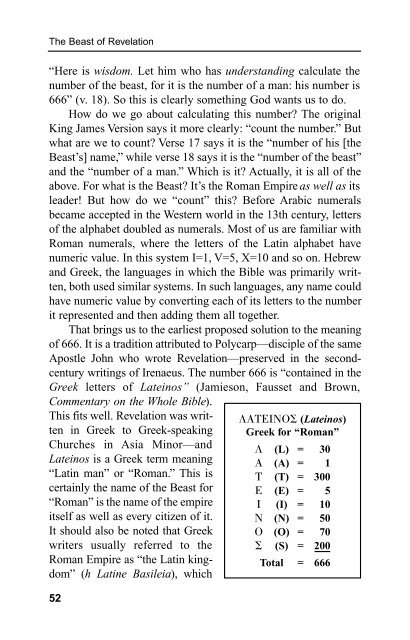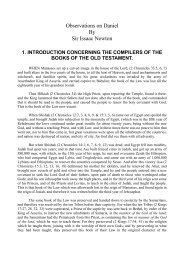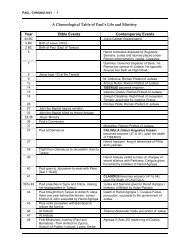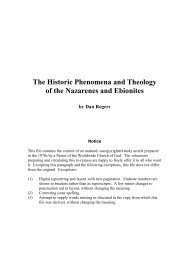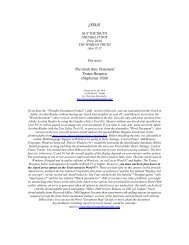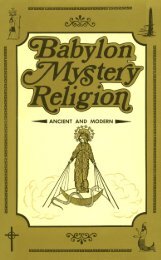Beast of Revelation.pdf - Friends of the Sabbath Australia
Beast of Revelation.pdf - Friends of the Sabbath Australia
Beast of Revelation.pdf - Friends of the Sabbath Australia
Create successful ePaper yourself
Turn your PDF publications into a flip-book with our unique Google optimized e-Paper software.
The <strong>Beast</strong> <strong>of</strong> <strong>Revelation</strong><br />
“Here is wisdom. Let him who has understanding calculate <strong>the</strong><br />
number <strong>of</strong> <strong>the</strong> beast, for it is <strong>the</strong> number <strong>of</strong> a man: his number is<br />
666” (v. 18). So this is clearly something God wants us to do.<br />
How do we go about calculating this number? The original<br />
King James Version says it more clearly: “count <strong>the</strong> number.” But<br />
what are we to count? Verse 17 says it is <strong>the</strong> “number <strong>of</strong> his [<strong>the</strong><br />
<strong>Beast</strong>’s] name,” while verse 18 says it is <strong>the</strong> “number <strong>of</strong> <strong>the</strong> beast”<br />
and <strong>the</strong> “number <strong>of</strong> a man.” Which is it? Actually, it is all <strong>of</strong> <strong>the</strong><br />
above. For what is <strong>the</strong> <strong>Beast</strong>? It’s <strong>the</strong> Roman Empire as well as its<br />
leader! But how do we “count” this? Before Arabic numerals<br />
became accepted in <strong>the</strong> Western world in <strong>the</strong> 13th century, letters<br />
<strong>of</strong> <strong>the</strong> alphabet doubled as numerals. Most <strong>of</strong> us are familiar with<br />
Roman numerals, where <strong>the</strong> letters <strong>of</strong> <strong>the</strong> Latin alphabet have<br />
numeric value. In this system I=1, V=5, X=10 and so on. Hebrew<br />
and Greek, <strong>the</strong> languages in which <strong>the</strong> Bible was primarily written,<br />
both used similar systems. In such languages, any name could<br />
have numeric value by converting each <strong>of</strong> its letters to <strong>the</strong> number<br />
it represented and <strong>the</strong>n adding <strong>the</strong>m all toge<strong>the</strong>r.<br />
That brings us to <strong>the</strong> earliest proposed solution to <strong>the</strong> meaning<br />
<strong>of</strong> 666. It is a tradition attributed to Polycarp—disciple <strong>of</strong> <strong>the</strong> same<br />
Apostle John who wrote <strong>Revelation</strong>—preserved in <strong>the</strong> secondcentury<br />
writings <strong>of</strong> Irenaeus. The number 666 is “contained in <strong>the</strong><br />
Greek letters <strong>of</strong> Lateinos” (Jamieson, Fausset and Brown,<br />
Commentary on <strong>the</strong> Whole Bible).<br />
This fits well. <strong>Revelation</strong> was written<br />
in Greek to Greek-speaking<br />
Churches in Asia Minor—and<br />
Lateinos is a Greek term meaning<br />
“Latin man” or “Roman.” This is<br />
certainly <strong>the</strong> name <strong>of</strong> <strong>the</strong> <strong>Beast</strong> for<br />
“Roman” is <strong>the</strong> name <strong>of</strong> <strong>the</strong> empire<br />
itself as well as every citizen <strong>of</strong> it.<br />
It should also be noted that Greek<br />
writers usually referred to <strong>the</strong><br />
Roman Empire as “<strong>the</strong> Latin kingdom”<br />
(h Latine Basileia), which<br />
52<br />
(Lateinos)<br />
Greek for “Roman”<br />
(L) = 30<br />
(A) = 1<br />
(T) = 300<br />
(E) = 5<br />
(I) = 10<br />
(N) = 50<br />
(O) = 70<br />
(S) = 200<br />
Total = 666


